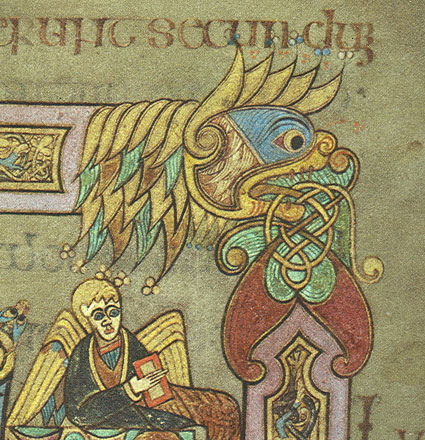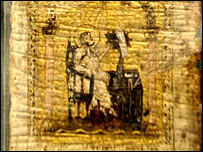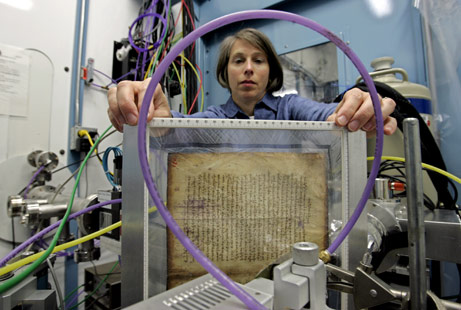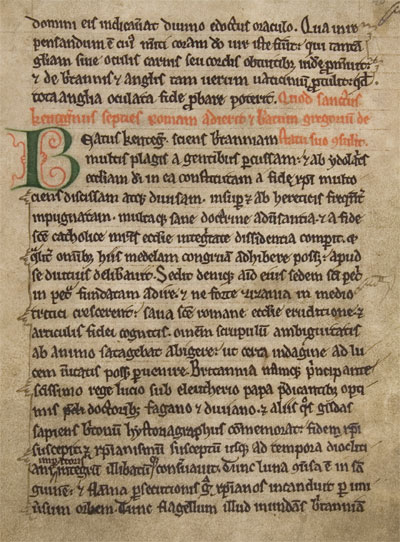Category — Medieval News
The Book of Kells in the News

There may be no more famous example of an illuminated manscript than the Book of Kells. While it is well known as one of the most beautiful surviving illuminated manscripts, surprisingly, very little is actually known about the manuscript and its origins. Finally, modern science will be used to learn more about this treasure. From the Dublin Journal as reported in the New York Times:
Experts at Trinity College in Dublin, where the Book of Kells has resided for the past 346 years, are allowing a two-year laser analysis of the treasure, which is one of Ireland’s great tourist draws.
The 21st-century laser technology being used, Raman spectroscopy, encourages hopes among those with a romantic view for an ecclesiastical intrigue like “The Da Vinci Code†or “The Name of the Rose.â€
But the precise subjects are more mundane. The laser will study the chemicals and composition of the book, its pigments, inks and pages of fine vellum. Experts estimate that 185 calves would have been needed to create the vellum on which the art and scriptures were reproduced.
This news happens to coincide with the opening of The Medieval Scriptorium’s on-line gallery of images from the Book of Kells. I have to admit that the gallery is not complete. I haven’t had time to finish all of the captions for the images but I decided to introduce it in this post in light of the recent story referenced above.
[tags]Book of Kells, illuminated manuscript, celtic, calligraphy[/tags]
May 29, 2007 1 Comment
Medieval Scribe, John Myronas, a 13th Century Parchment Recycler
 Yet another layer of history has been discovered in a Christian prayer book attributed to John Myronas. The most recent discovery is the third layer of text discovered in this recycled 13th century manuscript. In 2002, modern multi-sectional and multi-spectral imaging methods discovered greek writings from the 4th century. An article in the National Geographic News describes the earlier find:
Yet another layer of history has been discovered in a Christian prayer book attributed to John Myronas. The most recent discovery is the third layer of text discovered in this recycled 13th century manuscript. In 2002, modern multi-sectional and multi-spectral imaging methods discovered greek writings from the 4th century. An article in the National Geographic News describes the earlier find:
In 2002 researchers had uncovered writings by the mathematician Archimedes and the fourth-century B.C. politician Hyperides.
Last year one of the pages was found to contain a famous work by Archimedes about buoyancy that had previously been known only from an incomplete Latin translation.
A third layer has been been revealed and the details were presented today at the meeting of the American Philosophical Society by Reviel Netz and Roger Easton. From the BBC:
A series of clues, such as spotting a key name in the margin, led the team to its conclusion.
“The philosophical passage in the Archimedes Palimpsest is now definitely identified as a relatively early commentary to Aristotle’s Categories,” said Professor Netz.
He said that Aristotle’s Categories had served as the foundation for the study of logic throughout western history.
Further study has revealed the most likely author of this unique commentary is Alexander of Aphrodisias, Professor Robert Sharples from the University College London told BBC News.
If this is the case, he said, “it gives us part of a commentary previously supposed lost by the most important of those ancient commentators on Aristotle”.
From the National Geographic News:
n the 10th century a scribe had copied the ancient Greek manuscripts from papyrus scrolls onto parchment—thin leaves of treated animal skin.
Later the writing was washed out using a solvent such as orange juice and overwritten with new text—a process known as palimpsesting.
“In those days, parchment writing materials were so valuable that they were commonly reused when the book was considered out of date or if the subject was judged inappropriate or less valuable,” Roger L. Easton, of the Rochester Institute of Technology, wrote in an email.
By the 12th century, pages from five different earlier works had been erased, overwritten, and compiled into a Christian prayer book, the Euchologion—what is now called the Archimedes Palimpsest.

As always, books are multi-layered treasures. I wonder what else might be discovered in this 13th century prayer book?
[tags]Euchologion, Archimedes Palimpsest, Aristotle, Christian Prayer Book, 13th century, John Myronas, Philisophical Society, Archimedes, parchment, illuminated manscript[/tags]
April 26, 2007 Comments Off on Medieval Scribe, John Myronas, a 13th Century Parchment Recycler
The Return of the Vita of St. Kentigern to Glasgow – A Continuing Mystery
 A book depicting the life of St. Kentigern, a sixth century saint, was commissioned in the latter part of the 12th century. The finished manuscript was kept in the Glasgow Catherdral and mysteriously disappeared 400 years ago. From the Medieval Sourcebook, here is a bit of the history of the celtic manuscript that vanished:
A book depicting the life of St. Kentigern, a sixth century saint, was commissioned in the latter part of the 12th century. The finished manuscript was kept in the Glasgow Catherdral and mysteriously disappeared 400 years ago. From the Medieval Sourcebook, here is a bit of the history of the celtic manuscript that vanished:
The oldest extant source for Kentigern is the fragmentary Life of Saint Kentigern. This life consists of a preface and eight chapters. The author is only describes himself as a cleric of St. Kentigern who had travelled a great deal, and the preface states that the life was composed at the request of Herbert, bishop of Glasgow from 1147 to 1164. The anonymous author said that he found his material for the Life of Saint Kentigern in a little book of his miracles and from oral tradition.
This fragmentary life was used at Glasgow for about 30 years. At that time a new life was written by Jocelyn, a monk of Furness Abbey in northern Lancashire. This life was written at the request of Bishop Jocelyn, who was Bishop of Glasgow from 1175 to 1199. Jocelyn, the author, was at Down in Ireland in 1185, and so it is likely that he wrote his Life of Saint Kentigern sometime before then, perhaps about 1180. Jocelyn also states that he used a little book, written in the Scottic style, as a source for his life, as well as the life already at Glasgow and oral tradition.
From the Evening Times:
It’s a long-running whodunnit that’s baffled investigators for 400 years – who stole Glagow’s most historic book? The Vita St Kentigern – the story of the city’s patron saint – disappeared from its home at Glasgow Cathedral four centuries ago. The culprit has never been traced, far less brought to justice. Now, finally, the book has returned …
Approximately 300 years ago, a copy of the original manuscript was acquired by Archbishop Marsh of Dublin and it was held safely in that library until two years ago when the book was scanned and used to create four new copies of the ancient hagiography. Thus, after 400 years the story of the life of St. Kentigern has returned to Glasgow, Scotland. A page of that manuscript is shown below.

March 21, 2007 2 Comments
Joan of Arc at the Corcoran Gallery of Art in Washington, DC
 From November 18, 2006 through January 21, 2007, the Corcoran Gallery of Art in Washington, D.C. is presenting an exhibition on Joan of Arc (ce 1412-1431). There aren’t many historical figures with a more interesting resume than Joan of Arc. What’s more fun than a cross-dressing religious fanatic warrior who is burned at the stake and later made a saint. It’s good stuff and it has been an artistic inspiration for many over the centuries. From the gallery web site:
From November 18, 2006 through January 21, 2007, the Corcoran Gallery of Art in Washington, D.C. is presenting an exhibition on Joan of Arc (ce 1412-1431). There aren’t many historical figures with a more interesting resume than Joan of Arc. What’s more fun than a cross-dressing religious fanatic warrior who is burned at the stake and later made a saint. It’s good stuff and it has been an artistic inspiration for many over the centuries. From the gallery web site:
The exhibition surveys more than 200 French and American works produced over five centuries, including paintings, sculpture, illustrated books and manuscripts, textiles and popular art on loan from major institutions, including the Metropolitan Museum of Art, the National Gallery of Art, the John and Mable Ringling Museum, the Library of Congress, Harvard University, the Boston Public Library and Columbia University. These varied loans contextualize Boutet de Monvel’s Joan of Arc works in the Corcoran’s collection.
This represents a unique opportunity in the Washington, D.C. area to see illuminated manuscripts from a variety of institutions. In addition, it’s interesting to see the form that the Joan of Arc story has taken over the centuries.
[tags]illuminated manuscript, Corcoran Gallery of Art, Joan of Arc, medieval history, 15th century[/tags]
November 24, 2006 Comments Off on Joan of Arc at the Corcoran Gallery of Art in Washington, DC

